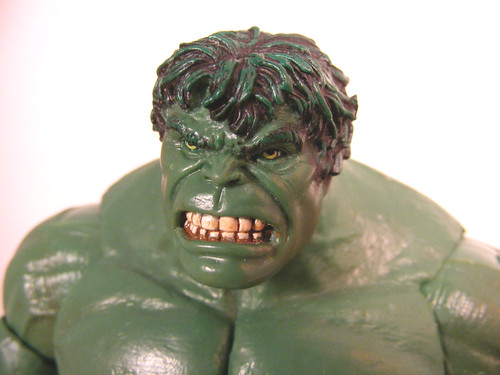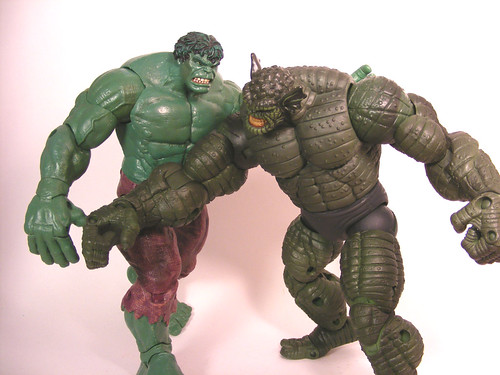Welcome to a brand-new feature I made up about ten seconds ago: Poe’s Action Figure Hall of Fame. These posts, appearing as regularly as I feel like writing them, will honor fine examples of action figure artistry.
The inaugural inductee is: Marvel Legends Face-Off Hulk!
Name: The Hulk
Line: Marvel Legends (Face-Off)
Year: 2006
Manufacturer: Toy Biz
Sculptor: Sam Greenwell
I prefer to have a nostalgic connection to the character of any action figure I buy. I can remember getting a little rubbery Hulk toy at Building 19 when I was a wee tyke (sadly, I can’t remember at all what it was or who made it). I was familiar with the character–what little kid wasn’t?–but I hadn’t read the comics, and I didn’t until the early 1990s during Peter David’s run. While David was making the Hulk smart by integrating his Bruce Banner and Hulk personalities, I got my second Hulk toy–the classic purple pants-wearing titan, made by the then-fledgling toy company Toy Biz. That first Toy Biz Hulk was shorter than most of other figures in the line, most likely because he was so muscled and the young Toy Biz had to conserve plastic to maintain prices (I’ll discuss this issue in more detail below).
Sixteen years later, Toy Biz–now a major player in the industry, with the hugely successful Marvel Legends and Lord of the Rings lines under its belt–released what would be its final Hulk action figure before Hasbro took over the Marvel license. This came after a long string of Hulks encompassing almost every conceivable incarnation, from the aforementioned Smart Hulk to “Joe Fixit” to his Jack Kirby-designed first appearance.
 But this final Toy Biz Hulk was something else.
But this final Toy Biz Hulk was something else.
I’ve noticed the superhero action figures being produced today seem to be strongly influenced by the so-called Bronze Age of Comics. This makes sense, since today’s superhero action figure market (at least in the six-inch scale) is strongly driven by collector input, if not collector sales necessarily. Since the average adult action figure collector is somewhere between their late twenties to early forties, their nostalgic childhood memories of superheroes probably stem from the 1970s to the early 1980s. The same probably holds true for the designers, sculptors, and marketers of said toys–so it makes sense that some of the best work can be found on versions of the characters from that era.
Face-Off Hulk (hereafter referred to simply as “Hulk,” or FO Hulk if I need to distinguish him) is clearly based on the Hulk of the late 1970s and early 1980s. The mop of long hair, the round head, the ape-like face, the purple pants–this is the Hulk young fans discovered when they were lured into the comics by the Bill Bixby television show, the Hulk whose comic featured the first appearance of Wolverine, the Hulk who shouldered an entire mountain range on his back during the Secret Wars.
This figure showcases Toy Biz at the pinnacle of their action figure producing prowess. Frankly, even their later Legendary Comic Book Heroes line seems a step backward from a figure like this–heck, even the Leader action figure that came packed with the Hulk looks a tad pathetic next to the perfection that is FO Hulk.
First off is the sculpting. Sam Greenwell’s work here represents one of the finest action figure sculpts I’ve ever seen. The figure’s look is strongly reminiscent of the character as drawn by Herb Trimpe in many of those 1970s issues. The detail is astounding; in the picture at the top of the post, check out the texture of the Hulk’s skin, the prominent veins and muscles, even the detail work of his hair–it’s all incredible (pardon the pun). This is the sort of quality I’d expect on a statue, not an action figure.
But there have been other action figure sculpts that were this good. What makes FO Hulk so amazing can be attributed to the less glamorous side of the action figure design business: paint applications and manufacturing.
There’s not a lot of paint on the Hulk–what with him being half-naked–but what there is is very well done. Again, look at his face–specifically his mother-of-pearl teeth, his dark gums, the angry yellow of his eyes. Even the purple pants have a light wash that brings out the square, stretched threads of the fabric.
Then there’s the manufacturing aspect. What’s important here are the size of the figure, the plastic used, and the amount of articulation.
As I mentioned above, many of the earliest Hulk figures were small because the figure was so heavily muscled, requiring a lot of plastic. At the time, toy companies tried to balance their production costs by having each figure use approximately the same amount of plastic. So a slender character could be very tall, but a beefy or fat character had to be short. When “waves” became the norm for action figures, it became easier to keep figures in scale by spreading the production costs out among five or six different figures; one wave could have three huge and three small figures, while another could have six medium-sized figures. That meant you sometimes had to pay a bit more than you’d like for a small figure, but you’d pay the same price for a much larger one.
(NOTE: Before some toy manufacturer comes in here and bawls me out for being an ignorant idiot, let me say that the explanation I’ve written above comes from what I’ve gleaned from the various interviews I’ve conducted, the trade magazines I’ve read, and manufacturer’s comments on various bulletin boards–with a dash of common sense. It’s quite possible I’m wrong on some or, heck, maybe most of the details, so don’t take all this as gospel. –PG)
Toy Biz took this concept a step further with their “Face-Off” two-packs, which pitted a superhero against his arch-nemesis. The Hulk came with the slender Leader, who probably required about a third or less the amount of plastic the Hulk needed. I doubt it was a perfect balance–I suspect this pair still cost more to make than, say, Captain America and the Red Skull–but it allowed us to get a Hulk in perfect scale to the rest of his Marvel Legends brethren.
One aspect of this figure that really shines is the plastic. This is something a lot of casual toy collectors might overlook, but there’s often a big difference in the sort of plastic used to make action figures. Sometimes the plastic is softer, giving the figure a more “realistic” feel, but also a more “toyish” look. Sometimes the plastic is bright and shiny, like Red Tornado, again giving the figure a toyish feel. And then sometimes, the plastic and the character come together in a perfect union, and that’s what happened with the Hulk. Thanks to the smooth, strong plastic used by ToyBiz, the Hulk looks like a Herb Trimpe drawing translated into the real world. It has just the right amount of shine one would expect on someone so heavily muscled, but it doesn’t make the figure look like a toy. Furthermore, it gives the figure some real heft, which is something I always like in a big action figure.
ToyBiz is famous for their super-articulated figures, and while Bruce Banner’s alter-ego doesn’t sport the thirty-plus points you’ll see on Spider-Man, he’s got the right amount for a big, beefy character. There’s the all-important ball jointed head, ball jointed shoulders and hips, and ankle and toe joints, as well as swivel biceps, wrists, and joints at the fingers. Unlike most Marvel Legends, Hulk has normal hinged knees and elbows instead of the double-hinge, which allows for greater movement. Again, this makes sense not only from a financial standpoint (the Hulk is a huge figure, and the more plastic and articulation you have, the more expensive the figure is), but from a real-world perspective as well; those with huge muscles can’t bend their limbs as tightly together as slender, lithe types.
Of course, no figure is perfect. The Hulk has three significant issues:
- The paint applications at the top of his pants are incomplete, making it look like they turn green at the top;
- His arms are made from a slightly brighter-colored plastic, which makes the green contrast with the torso show up sharply under strong lights;
- But the most egregious issue are his hands. The Hulk needs to have fists, period. The Hulk smashes things, and he can’t do it very well with two open hands (unless he does that silly “super-clap” move). ToyBiz managed to give the smaller Savage Dragon figure fully articulated fingers; why not the Hulk? Again, I imagine it comes down to a cost issue, but if that’s the case, they should have just sculpted closed fists instead of open hands. Yes, his fingers are articulated and you can close them, but they don’t look right.
But these minor flaws serve to highlight the perfection of the rest of the figure. While I’ve been critical of some Marvel Legends figures in the past–I’ve never really liked the double-hinged elbows and knees, and the sculpts can vary wildly in quality–this is one figure I intend to honor as a prized piece in my collection.


